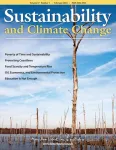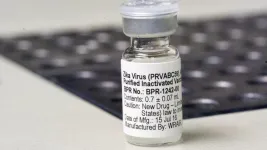(Press-News.org) RICHLAND, Wash.—There’s a down side to “smart” devices: They can be hacked.
That makes the electric grid, increasingly chock full of devices that interact with one another and make critical decisions, vulnerable to bad actors who might try to turn off the power, damage the system or worse.
But smart devices are a big part of our future as the world moves more toward renewable energy and the many new devices to manage it. Already, such tools play a big role in keeping the power humming. The portion of the grid owned by utilities has thousands of devices that can be targeted, including transformers and generators. And then there are devices owned by customers, municipalities and others, such as solar panels and charging stations. With so many devices as well as an array of partners who have a stake in the grid, it’s becoming more taxing than ever to prevent or stop every potential attack.
At the recent annual meeting of the Association for the Advancement of Artificial Intelligence in Vancouver, Canada, a team of experts at the Department of Energy’s Pacific Northwest National Laboratory put forth a new approach to protect the grid.
The team, led by data scientist Sumit Purohit, is trying to leapfrog current practices and create a better level of protection. Instead of protecting the electric grid and its tens of thousands of components piece by piece, the team is creating a tool that sorts and prioritizes cyber threats on the fly. The idea is to give grid operators a clear blueprint to identify and address the biggest threats first and to protect against them without a mad scramble for resources down the road.
“A great deal of effort is put forth every day into addressing specific vulnerabilities, but that can be overwhelming,” said Purohit. “We’re putting forth a longer-term solution. What do you need to be looking at, not just today or tomorrow, but years down the road, as the grid is changing?
“It’s important to deal with today’s problems, but let’s also think about tomorrow’s challenges. We need to plan for things down the line as more smart devices like batteries, inverters, generators and hybrid cars are connected to the grid,” Purohit added.
It’s a bit like the difference between addressing ailments one at a time compared to embarking on decades of preventive health. A person might break a hip falling at home one year, end up in the ER with a bad case of pneumonia a few years later, and then have a heart attack. Of course, getting the best treatment for each condition is critical.
An alternate path is to map out the most critical wellness behaviors early on and to give those high priority throughout life. That might include staving off osteoporosis by eating a healthy diet and being active, receiving vaccines to prevent as much illness as possible, and avoiding smoking and eating less fat to keep the heart healthy.
Mapping cyberattack paths
The team’s formula is based on a model known as hybrid attack graphs, a mathematical approach that is becoming more popular as the cyber and physical worlds become interconnected. The approach gives users flexibility to map out and follow multiple attack routes as they evolve and as defenders and attackers give and take ground. The team uses optimization and data from actual grid cyberattacks to train the model.
The project is one of hundreds of efforts at PNNL to improve artificial intelligence or apply it to address the nation’s greatest challenges. The research led by Purohit is an example of work on energy resilience, an important mission area of the Center for AI @ PNNL.
The research draws on research previously done by MITRE Corp. that links high-level objectives of adversaries with the techniques they have used as well as ways to prevent attacks. But the framework does not include information about the “cost” to an organization, in terms of effort or money, to implement those protections. The PNNL team is trying to change that by addressing the cost of implementing solutions.
“This approach would allow a utility to quickly assess its cyber risk as they are planning their future grid expansion,” said Purohit. “If you plan to connect more smart devices in the future, you need to be prepared to address the risks. There are thousands of ways to attack utility operations. By looking at historical events and using reinforcement learning, we have reduced that to fewer than 100 that need the most attention.”
Data scientist Rounak Meyur, who worked on the project, added that “Our work aims not only to maximize available resources but also to consider what might need to be done to augment or improve existing capabilities.”
A key part of the team’s work is making sure the work is “explainable”—that grid operators and cyber analysts understand the reasons why the model prioritizes and makes the recommendations it does.
“If your favorite movies aren’t recommended by a streaming service, and you don’t understand why, that’s inconvenient but not a real problem,” said Purohit. “But grid operators must keep the power on, and they need to understand the reasoning behind every action they might take.”
The team is working to improve the model and plans to work with power grid and cybersecurity experts to better measure the impacts of adversarial actions on cyber-physical systems.
PNNL researcher Braden Webb also contributed to the project. The research, funded by PNNL, is part of a Laboratory project called Resilience through Data-driven, Intelligently Designed Control, where cybersecurity scientist Thomas Edgar and others are part of the effort.
“Right now, in some ways, keeping power flowing and keeping the grid safe is more art than science,” said Edgar. “Our approach is grounded in science and would help the utility know in a more definitive way where to invest to get the most bang for its buck in terms of protecting itself from attack.”
# # #
END
Plant genomics has come a long way since Cold Spring Harbor Laboratory (CSHL) helped sequence the first plant genome. But engineering the perfect crop is still, in many ways, a game of chance. Making the same DNA mutation in two different plants doesn’t always give us the crop traits we want. The question is why not? CSHL plant biologists just dug up a reason.
CSHL Professor and HHMI Investigator Zachary Lippman and his team discovered that tomato and Arabidopsis thaliana plants can use very different regulatory systems to control the same exact ...
1. Using data science techniques, a NIMS–Tohoku University research team has discovered that different thermal conductivities exhibited by an amorphous material with the same composition are attributable to the sizes of atomic rings in its atomic structure. This is one of the first studies demonstrating that the structural features of amorphous materials can be correlated with their physical properties.
2. It is already feasible to synthesize amorphous materials with the same compositions but different thermal conductivities. However, the structural factors responsible for differences in thermal conductivity had yet to be identified due to a lack of appropriate analytical ...
Male breast cancer has distinct alterations in the tumor genome that may suggest potential treatment targets, according to a study by Weill Cornell Medicine investigators. They have conducted the first whole genome sequencing analysis of male breast cancer, which looked at the complete DNA landscape of tumor samples from 10 patients.
This is an important step in viewing breast cancer in men, which represents less than 1 percent of all breast cancer cases each year, as a unique disease. Though most research has focused on women with breast cancer, the incidence in men has increased at a much faster rate than in women over the last 40 years. Also, ...
According to the CDC, the suicide rate among young people ages 10‒24 increased 62% from 2007 through 2021. The CDC’s Youth Risk Behavior Summary reports that in 2021, 22% of high school students seriously considered attempting suicide during the year and 18% made a suicide plan. These statistics indicate a mental health crisis facing our youth. How can we identify children in crisis? Who is being missed?
The Brain & Behavior Research Foundation (BBRF) is hosting a free webinar, “Detection of Suicide-Related Emergencies Among ...
Madhavi Venkatesan, PhD, Editor-in-Chief of the peer-reviewed journal Sustainability and Climate Change and founder of Sustainable Practices, has been named USA TODAY Woman of the Year for the state of Massachusetts in recognition of her outstanding efforts to eliminate single-use plastic bottles across Cape Cod and the Islands.
With economics and sustainability at the forefront, Venkatesan established Sustainable Practices in 2016, aiming to address pressing environmental issues through innovative solutions. Since then, she and her nonprofit team have spearheaded ...
In the predawn hours of Sept. 5, 2021, engineers achieved a major milestone in the labs of MIT’s Plasma Science and Fusion Center (PSFC), when a new type of magnet, made from high-temperature superconducting material, achieved a world-record magnetic field strength of 20 tesla for a large-scale magnet. That’s the intensity needed to build a fusion power plant that is expected to produce a net output of power and potentially usher in an era of virtually limitless power production.
The test was immediately declared ...
A vaccine against Zika virus is safe and effective when administered both before and during pregnancy, according to new research published in npj Vaccines.
The purified, inactivated Zika vaccine (ZPIV) candidate, developed by Walter Reed Army Institute of Research (WRAIR), is being evaluated in animal models at Texas Biomedical Research Institute (Texas Biomed) in collaboration with WRAIR and Trudeau Institute in New York.
The vaccine candidate has previously been shown to effectively block prenatal Zika virus transmission when given to nonhuman primates ...
PROVIDENCE, R.I. [Brown University] — Childhood lead exposure, primarily from paint and water, is a significant health concern in the United States, but a new study has identified a surprising additional source of lead exposure that may disproportionately harm children: firearms.
A team led by researchers at Brown University found an association between household firearm ownership and elevated lead levels in children’s blood in 44 states, even when controlling for other major lead exposure ...
The role of African women and young people engaged in agricultural service provision has been investigated in a new CABI-led study published in the CABI Agriculture and Bioscience journal.
By combining a literature review with ongoing action research in Kenya, the scientists provide insights into the main characteristics, benefits, and shortfalls of business models for engaging women and young people in agricultural service provision in Africa.
‘Not a panacea to the challenges faced’
The findings show that the engagement of African women and young people in agricultural service provision is ‘not a panacea to the challenges they face’ such as limited ...
The Redox Medicine Society (RMS) is pleased to announce the 26th International Conference of the Redox Medicine, taking place from June 27 to June 28, 2024, in Paris, France. Redox Medicine 2024 will gather the world’s leading experts in redox biology, signaling pathways, and their impact on medicine, promising to highlight the current and future state of Redox Medicine.
The influence of redox processes, redox biology, and redox signaling pathways extends across a broad spectrum of physiological and pathological phenomena. A deeper comprehension of the cellular and molecular mechanisms driving these redox interactions is pivotal for the development of innovative ...







